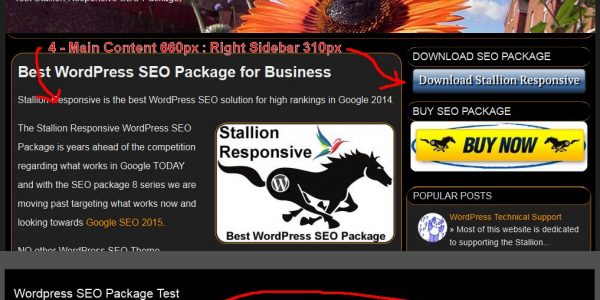Comment on Stallion Responsive SEO Theme Layout Options by SEO Dave.

You have two choices.
Use the example template (made for this reason) and modify to your needs, that’s the file page-example.php
This is basically the page.php template (it’s used to make basic Static Pages) with some info at the top to tell WordPress it’s a custom page template called “Example Default”.
Easiest way to use this template is make a copy of page-example.php and rename the copy to something unique like page-my-custom.php
Edit in a text editor and change the line
Template Name: Example Default
To something like
Template Name: Andrei Custom Page
If you use the Stallion Responsive Child theme upload to
/wp-content/themes/stallion-responsive-child/
If not using the child them upload to
/wp-content/themes/stallion-responsive/
Note: if you use the latter make sure you have an offine copy, when you update Stallion you will loose the file, storing it in the child folder protects it from being deleted during updates. I’m afraid that’s how WordPress works, when you update a plugin or a theme using the built in updater WordPress deletes the theme/plugin folder and installs the updates theme/plugin. By using a child theme and storing modified files in the child theme folder the modifications aren’t deleted.
You can now use your new template (it would be called “Andrei Custom Page”) on any Static Page or if you’ve set the right Stallion settings (options under the “Stallion Layout Options” page “Custom Templates ON”) also on WordPress posts.
To add new features, make changes you edit page-my-custom.php what you do is up to you.
The other alternative is find a current page template that’s close to what you want, there’s over 20 built into Stallion. They mostly start with page-***.php and the sitemap ones start sitemap-****.php.
Example page-front-01.php “Template Name: Front 1 – Page Content and Archive Posts”
To make a new template based on this you’d make a copy of page-front-01.php and rename exactly the same way as described above.
Your only limited by your PHP skills and imagination :-)
David


More Comments by SEO Dave
WordPress SEO Theme Layout
WordPress Clone Plugins and SEO Theme Options
There’s isn’t an export Stallion SEO settings per se, you could of course clone a site which will cone everything if you plan to build a lot of new sites that can save a lot of time: setup one empty …
Continue Reading WordPress SEO Theme Design
WordPress SEO Theme Layout
WordPress Static Page HomePage
That’s just a static page.
Created a WordPress Static Page, added content as you do :-)
“Settings” >> “Reading”
Tick “A static page (select below)”
Select the WordPress Static Page I made.
I did create a new WordPress Custom Page Template for this page which …
Continue Reading WordPress SEO Theme Design
WordPress SEO Theme Layout
Google Search Engine Optimization Guide 2015
With most of what I write about SEO it’s aiming for the best possible search engine optimized website possible.
As you’ve touched on there’s a time issue, setting 6 phrases as you write a new article is manageable, editing hundreds of …
Continue Reading WordPress SEO Theme Design
WordPress SEO Theme Layout
SEO Posts Widget Image Links
Regarding the SEO Posts widget linked thumbnail images, if you’ve updated to Stallion Responsive 8.1 you can limit the number of thumbnail images like you see on my left sidebar.
I have the popular posts widget and the recent posts widget …
Continue Reading WordPress SEO Theme Design
WordPress SEO Theme Layout
SEO WordPress Strategy 2015
For usability reasons (users come first) I wouldn’t remove the link part of the images, it would likely confuse site visitors.
Looking at your site amishamerica.com you aren’t using Stallion Responsive to it’s full SEO capabilities.
For example the links you are …
Continue Reading WordPress SEO Theme Design
WordPress SEO Theme Layout
WordPress Design Layouts
There’s dozens of Stallion layouts and color schemes each with their own CSS files, so depends what layout and color schemes you’ve set.
You’ll find all CSS files under /stallion-seo-theme/colors/ basically a site will use one layout file and one color …
Continue Reading WordPress SEO Theme Design
WordPress SEO Theme Layout
Disable WordPress Search Form
The header search form isn’t a widget it’s built in to the theme, to disable go to
Stallion Layout Options : Search Form OFF
This activates the Header Widget Area so you can add something else there via a widget: there’s limited …
Continue Reading WordPress SEO Theme Design
WordPress SEO Theme Layout
Comments WordPress Page Templates
Disabling comments on a post is a core WordPress feature, on the edit page there’s a setting.
There’s a Stallion feature under the Stallion Layout options page to turn all dates and author links sitewide off, no built in way to …
Continue Reading WordPress SEO Theme Design
WordPress SEO Theme Layout
WordPress Theme Copyright Notice Date
Changing the copyright date isn’t a theme option, it’s based on the date of your earliest post.
That being said if you don’t mind changing code, I suppose you could add any date by replacing this code with any date:
The file …
Continue Reading WordPress SEO Theme Design
WordPress SEO Theme Layout
WordPress Responsive Theme CSS Max-Width of Images
That’s a WordPress responsive theme CSS setting called max-width within the Stallion layout CSS files so images never stretch over the sidebars.
Under /stallion-seo-theme/colors/ you’ll find the layout CSS files name format layout-***.css where the *** relates to the layout used, …
Continue Reading WordPress SEO Theme Design
WordPress SEO Theme Layout
SEO Content High in Code
In SEO theory having your most important content higher in the code as possible makes sense, BUT the actual evidence it matters a lot is weak at best.
If there is an SEO impact it’s very small.
There is an argument loosing …
Continue Reading WordPress SEO Theme Design
WordPress SEO Theme Layout
SEO vs Website Design
I completely agree, the difficulty is creating a great looking page without it costing on the SEO side.
Easy to take everything away from the home page with Stallion via the Page templates, but take out all the sidebar links etc… …
Continue Reading WordPress SEO Theme Design